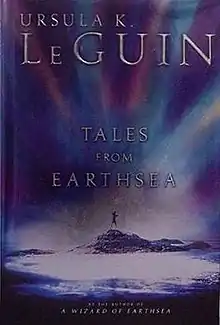 First edition iridescent cover | |
| Author | Ursula K. Le Guin |
|---|---|
| Cover artist | Kelly Nelson (design) Marion Wood Kolisch (photo) |
| Country | United States |
| Language | English |
| Series | Earthsea |
| Genre | Fantasy |
| Published | 2001 (Harcourt Brace & Company) |
| Media type | Print (hardcover) |
| Pages | 296 |
| ISBN | 0-15-100561-3 |
| OCLC | 45813870 |
| [Fic] 21 | |
| LC Class | PZ7.L5215 Tal 2001 |
| Preceded by | Tehanu |
| Followed by | The Other Wind |
Tales from Earthsea is a collection of fantasy stories and essays by American author Ursula K. Le Guin, published by Harcourt in 2001. It serves as an accompaniment to the five novels (1968 to 2001) of the Earthsea cycle, all set in the fictional archipelago Earthsea.[1]
Tales from Earthsea won the annual Endeavour Award, for the best book by a writer from the Pacific Northwest,[2] and Locus Award, Best Collection, for speculative fiction collections.[3] Two of the five collected stories were previously published, "Darkrose and Diamond" (1999) and "Dragonfly" (1998),[1] and both had been nominated for annual awards.[3]
Contents
- Foreword
- "The Finder". The school of magic is established on Roke island.
- "Darkrose and Diamond" (1999). The daughter of a witch and the son of a rich merchant love each other.
- "The Bones of the Earth". Ogion the Silent helps his wizard master deal with an earthquake.
- "On the High Marsh". A mysterious healer arrives in a remote village threatened by a livestock epidemic.
- "Dragonfly" (1998). This is a postscript to the novel Tehanu.
- "A Description of Earthsea" (reference material)
"Darkrose and Diamond" was first published in The Magazine of Fantasy and Science Fiction, October 1999. "Dragonfly" was first published in Legends, October 1998.[1]
Themes
All of the stories reinterpret the world of Earthsea. In the original trilogy, Earthsea society in general and the practice of magic in particular are dominated by men. Women can only be witches, which is the despised lowest rank of the magical world, as expressed in the proverb "Weak as women's magic, wicked as women's magic".
The Tales from Earthsea stories try to redress the balance. It is disclosed that the Roke school had been established by women who were later excluded from it; and that Ogion, Ged's beloved tutor and mentor, had learned his magic from a master who had learned from an "unauthorised" woman mage. Other stories feature strong and assertive women who in various ways challenge male dominance.
References
- 1 2 3 Earthsea Cycle series listing at the Internet Speculative Fiction Database. Retrieved 2012-02-25.
- ↑ "Endeavour Award History". Endeavour Awards. Retrieved 2011-07-10.
- 1 2 "Ursula K. Le Guin" Archived 2015-09-12 at the Wayback Machine. Index of Literary Nominees. The Locus Index of SF Awards. Locus. Retrieved 2012-02-25.
Sources
- Bernardo, Susan M.; Murphy, Graham J. (2006). Ursula K. Le Guin: A Critical Companion (1st ed.). Westport, CT: Greenwood Press. ISBN 0-313-33225-8.
- Cadden, Mike (2005). Ursula K. Le Guin Beyond Genre: Fiction for Children and Adults (1st ed.). New York, NY: Routledge. ISBN 0-415-99527-2.
- Martin, Philip (2009). A Guide to Fantasy Literature: Thoughts on Stories of Wonder & Enchantment (1st ed.). Milwaukee, WI: Crickhollow Books. ISBN 978-1-933987-04-0.
- Talvekar, Mandar (November 25, 2005). "Book Review: Tales from Earthsea". Ink Scrawl: opening my universe a little more (blog). blogger.com. Retrieved 2012-02-25.
External links
- Tales from Earthsea title listing at the Internet Speculative Fiction Database